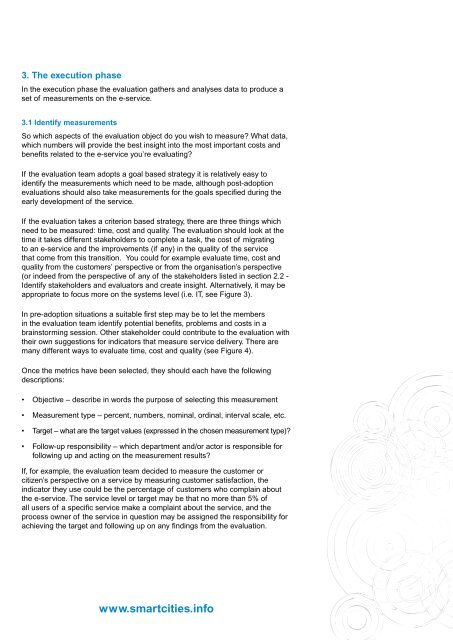Evaluating the impact of local e-services - Smart Cities
Evaluating the impact of local e-services - Smart Cities
Evaluating the impact of local e-services - Smart Cities
You also want an ePaper? Increase the reach of your titles
YUMPU automatically turns print PDFs into web optimized ePapers that Google loves.
3. The execution phase<br />
In <strong>the</strong> execution phase <strong>the</strong> evaluation ga<strong>the</strong>rs and analyses data to produce a<br />
set <strong>of</strong> measurements on <strong>the</strong> e-service.<br />
3.1 Identify measurements<br />
So which aspects <strong>of</strong> <strong>the</strong> evaluation object do you wish to measure? What data,<br />
which numbers will provide <strong>the</strong> best insight into <strong>the</strong> most important costs and<br />
benefits related to <strong>the</strong> e-service you’re evaluating?<br />
If <strong>the</strong> evaluation team adopts a goal based strategy it is relatively easy to<br />
identify <strong>the</strong> measurements which need to be made, although post-adoption<br />
evaluations should also take measurements for <strong>the</strong> goals specified during <strong>the</strong><br />
early development <strong>of</strong> <strong>the</strong> service.<br />
If <strong>the</strong> evaluation takes a criterion based strategy, <strong>the</strong>re are three things which<br />
need to be measured: time, cost and quality. The evaluation should look at <strong>the</strong><br />
time it takes different stakeholders to complete a task, <strong>the</strong> cost <strong>of</strong> migrating<br />
to an e-service and <strong>the</strong> improvements (if any) in <strong>the</strong> quality <strong>of</strong> <strong>the</strong> service<br />
that come from this transition. You could for example evaluate time, cost and<br />
quality from <strong>the</strong> customers’ perspective or from <strong>the</strong> organisation’s perspective<br />
(or indeed from <strong>the</strong> perspective <strong>of</strong> any <strong>of</strong> <strong>the</strong> stakeholders listed in section 2.2 -<br />
Identify stakeholders and evaluators and create insight. Alternatively, it may be<br />
appropriate to focus more on <strong>the</strong> systems level (i.e. IT, see Figure 3).<br />
In pre-adoption situations a suitable first step may be to let <strong>the</strong> members<br />
in <strong>the</strong> evaluation team identify potential benefits, problems and costs in a<br />
brainstorming session. O<strong>the</strong>r stakeholder could contribute to <strong>the</strong> evaluation with<br />
<strong>the</strong>ir own suggestions for indicators that measure service delivery. There are<br />
many different ways to evaluate time, cost and quality (see Figure 4).<br />
Once <strong>the</strong> metrics have been selected, <strong>the</strong>y should each have <strong>the</strong> following<br />
descriptions:<br />
• Objective – describe in words <strong>the</strong> purpose <strong>of</strong> selecting this measurement<br />
• Measurement type – percent, numbers, nominal, ordinal, interval scale, etc.<br />
• Target – what are <strong>the</strong> target values (expressed in <strong>the</strong> chosen measurement type)?<br />
• Follow-up responsibility – which department and/or actor is responsible for<br />
following up and acting on <strong>the</strong> measurement results?<br />
If, for example, <strong>the</strong> evaluation team decided to measure <strong>the</strong> customer or<br />
citizen’s perspective on a service by measuring customer satisfaction, <strong>the</strong><br />
indicator <strong>the</strong>y use could be <strong>the</strong> percentage <strong>of</strong> customers who complain about<br />
<strong>the</strong> e-service. The service level or target may be that no more than 5% <strong>of</strong><br />
all users <strong>of</strong> a specific service make a complaint about <strong>the</strong> service, and <strong>the</strong><br />
process owner <strong>of</strong> <strong>the</strong> service in question may be assigned <strong>the</strong> responsibility for<br />
achieving <strong>the</strong> target and following up on any findings from <strong>the</strong> evaluation.<br />
www.smartcities.info



